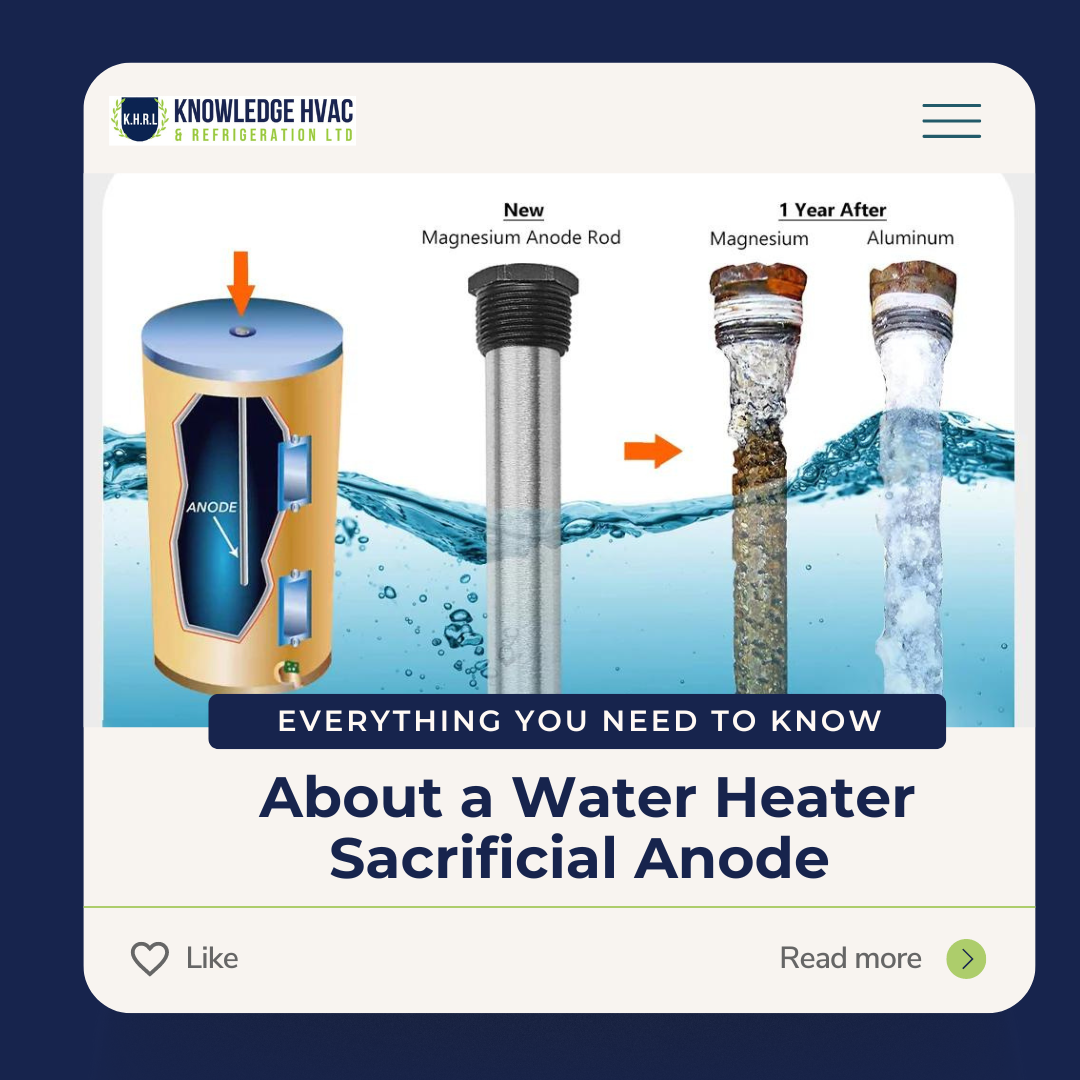When it comes to extending the lifespan of your water heater and maintaining its efficiency. One of the most important components is the sacrificial anode. This often-overlooked part, plays a vital role in preventing your water heater tank from rusting, ensuring it lasts as long as possible. Here’s everything you need to know about water heater sacrificial anodes, how they work, and why they’re essential.
You might also want to read:
Why Consider a Hybrid Water Heater for Your Home?
How to Extend Your Tankless Water Heater’s Life with Descaling
What is a Sacrificial Anode?
A sacrificial anode is a metal rod, typically made of magnesium, aluminum, or zinc, that is inserted into the water heater tank. It is called “sacrificial” because it is designed to corrode or deteriorate over time, protecting the inner lining of the water heater tank from rust and corrosion. Without this anode, the metal walls of the tank would quickly rust, significantly reducing the water heater’s lifespan.

How Does a Sacrificial Anode Work?

The science behind the sacrificial anode relies on a process called electrochemical corrosion. Different metals corrode at different rates based on their electrochemical potential. The anode rod, made of a more reactive metal, attracts corrosive elements in the water, such as chloride and sulfate ions.
Instead of these elements corroding the tank, they corrode the anode rod first. As long as the anode rod is intact, the metal tank stays protected. Once the anode corrodes to the point of depletion, the tank itself becomes vulnerable to corrosion.
Types of Sacrificial Anodes?
Magnesium Anode Rods:
These are the most common type of anode rods. Magnesium has a higher electrochemical potential, making it very effective at protecting the tank. However, it tends to wear out faster than other materials, especially in hard water conditions.Aluminum Anode Rods:
Aluminum anodes are less expensive and tend to last longer than magnesium rods. They are often used in areas with hard or softened water, which can wear out magnesium rods more quickly. However, aluminum can produce a gel-like residue that may settle at the bottom of the tank, requiring occasional cleaning.Zinc-Aluminum Anode Rods:
Zinc is often added to aluminum rods (typically 10% zinc) to reduce the production of sulfur-smelling bacteria in the water, which can cause a rotten egg odor. These rods are ideal for water heaters installed in areas with sulfur content in the water.Powered Anode Rods:
These are a more advanced and permanent solution. Unlike sacrificial anode rods, powered anodes use electricity to prevent corrosion without the need for material depletion. They are especially useful for heaters in hard water areas and can be ideal for long-term water heater maintenance.
Signs Your Sacrificial Anode Needs Replacement
- Rusty Water:
If you notice rusty water coming from your hot water tap, it could mean that the anode rod has depleted, allowing the tank to corrode. Unusual Noises:
Popping or banging noises from the tank could be a sign that sediment has built up on the bottom, which might indicate an exhausted anode.Hot Water Smells Like Rotten Eggs:
This unpleasant odor is often caused by sulfur bacteria interacting with the anode. While switching to a zinc-aluminum anode can help, it might also indicate it’s time to replace the rod.Visible Wear on the Rod:
If you remove the rod for inspection, it should be replaced if it’s reduced to less than ½ inch in diameter or if it’s covered in calcium deposits or corrosion.
How Often Should You Replace the Sacrificial Anode?

The lifespan of a sacrificial anode varies depending on water quality, tank usage, and the type of anode. Typically, a standard anode rod will last anywhere from 3 to 5 years, but it’s recommended to inspect the rod annually, especially if you live in an area with hard water or use a water softener, which can accelerate anode wear.
How to Replace a Sacrificial Anode
Turn Off Power and Water Supply:
For electric heaters, switch off the power at the circuit breaker. For gas heaters, turn the gas valve to “Pilot” mode. Shut off the cold water supply to the tank.Drain a Small Amount of Water:
Attach a hose to the drain valve at the bottom of the tank and drain a few gallons of water to reduce pressure.Locate and Remove the Anode:
The anode rod is typically located on top of the water heater, sometimes hidden under a plastic cap. Use a socket wrench to unscrew it. Be prepared—it may be difficult to remove if it’s been in place for years.Install the New Anode:
Insert the new anode rod and tighten it into place. If the space above your water heater is limited, you can purchase a segmented anode rod that bends as you insert it.Restore Water and Power:
Turn the water supply back on and check for leaks around the anode rod. Once the tank is full, restore power to the heater.
The Importance of Maintaining the Sacrificial Anode

A well-maintained anode rod can significantly extend the life of your water heater, preventing costly repairs and replacements. Neglecting this small but vital component can result in rust buildup and eventual tank failure, leading to water heater leaks and damage to your home.
Regularly inspecting and replacing the sacrificial anode when necessary is a key part of water heater maintenance. By doing so, you are ensuring your water heater provides efficient service for years to come.
NOTE:
The sacrificial anode is small but an important part within the hot water storage tank. This is often a forgotten component, but it plays a crucial role in the longevity and performance of your water heater. Understanding how it works and knowing when to replace it can save you from unexpected breakdowns and costly replacements. Regular inspection and maintenance of the anode rod can extend the life of your water heater, ensuring you have reliable hot water when you need it.







